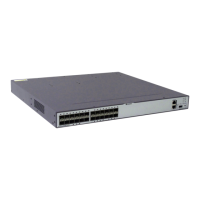system-view
The system view is displayed.
2. Run:
ospfv3 [ process-id ]
The OSPFv3 view is displayed.
3. Run:
area area-id
The OSPFv3 area view is displayed.
4. Run:
abr-summary ipv6-address prefix-length [ cost cost | not-advertise ]
*
Route summarization is configured in the OSPFv3 area.
cost cost set the cost of a summarized route. By default, the cost of a summarized
route is the maximum cost among those of routes that are summarized. The value
ranges from 1 to 16777214.
If not-advertise is set, no routing information of the network segment is advertised.
----End
5.8.3 Configuring OSPFv3 to Filter the Received Routes
By configuring filtering conditions for routing information, you can allow only the routes that
pass the filtering to be received or advertised.
Context
After receiving LSAs, OSPFv3 determines whether to add the calculated routes to the local
routing table according to the filtering policy.
Do as follows on the switch that runs OSPFv3.
Procedure
Step 1 Run:
system-view
The system view is displayed.
Step 2 Run:
ospfv3 [ process-id ]
The OSPFv3 view is displayed.
Step 3 Run:
filter-policy { acl6-number | acl6-name acl6-name | ipv6-prefix ipv6-prefix-name }
import
OSPFv3 is configured to filter the imported routes.
Using the filter-policy command, you can only filter the routes calculated by OSPFv3. Routes
that do not pass the filtering are neither added to the OSPFv3 routing table nor advertised.
----End
S6700 Series Ethernet Switches
Configuration Guide - IP Routing 5 OSPFv3 Configuration
Issue 01 (2012-03-15) Huawei Proprietary and Confidential
Copyright © Huawei Technologies Co., Ltd.
203

